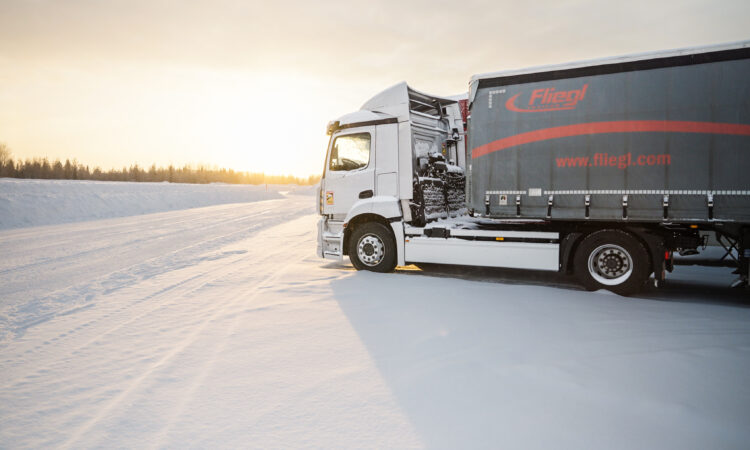- Development and test engineers from Mercedes-Benz Trucks have subjected the eActros 300 as a tractor unit to practical tests for six consecutive days, covering a distance of around 3,000 kilometers.
- The heavy-duty distribution truck also impresses on long routes in a wide variety of climatic and topographical conditions.
- The e-truck scores high marks along the way with its powerful acceleration, range-increasing recuperation, and quiet handling.
- Its driver assistance systems work reliably even in adverse weather conditions.
- Dr. Christof Weber, Head of Global Testing Mercedes-Benz Trucks: “The journey from Rovaniemi to Stuttgart showed that the eActros 300 as a tractor unit reliably masters all challenges before its market launch in autumn this year. This applies in terms of energy efficiency and charging, as well as driving comfort and safety.”
Leinfelden-Echterdingen – Driving a battery-electric heavy-duty distribution truck from the Arctic Circle to Stuttgart is something special – even for experienced developers. In future, customers are not likely to use the Mercedes-Benz eActros 300 as a tractor unit for this kind of a long journey. However, being able to test the vehicle in real operation for several days at a time under the most varied climatic and topographical conditions is the best opportunity for the developers to derive measures for possible optimisation of the functions and systems. The experts from Mercedes-Benz Trucks covered around 3,000 kilometers in March with a near-series prototype of the eActros 300 as a tractor unit. The electric truck, which was specially designed for flexible use in heavy-duty distribution haulage, celebrated its trade fair premiere at IAA Transportation 2022 in Hanover. Its start of production is scheduled for autumn this year.
Before the 3,000-kilometer journey, Mercedes-Benz Trucks engineers had already extensively tested the vehicle in winter conditions as part of the tests in Rovaniemi, Finland. At temperatures of down to minus 25 degrees, in addition to handling on icy and snowy roads, the focus was particularly on the starting properties and protection of the drive components, software and interfaces from low temperatures. On the return journey, the main objective was to take a closer look at the eActros loaded to 25 tons in real traffic.
Dr. Christof Weber, Head of Global Testing Mercedes-Benz Trucks: “The journey from Rovaniemi to Stuttgart showed that the eActros 300 as a tractor unit reliably masters all challenges before its market launch in autumn this year. This applies in terms of energy efficiency and charging, as well as driving comfort and safety.”
Relaxed, comfortable and safe cruising without fears of limited range
Rovaniemi, Stockholm, Malmö, Copenhagen, Nyborg, Flensburg, Hamburg, then on the A7 highway down to Würzburg and from there via the A81 highway back to Stuttgart: A real marathon for the eActros 300 as a tractor unit, whose three battery packages – each with 112 kWh[1] of installed battery capacity – enable a range of up to 220 kilometers[2] without opportunity charging.
“In advance, we planned the individual stages precisely and very conservatively with around 150 kilometers in order to be able to drive to the planned charging points without any problems, even in traffic jams or stop-and-go traffic,” reports Marc Schniederjan, team leader at Mercedes-Benz Trucks, responsible for the operation of test vehicles and who coordinated and supervised the return journey.
On the road on European and main roads, as well as highways with different topography, drivers were impressed by the relaxed driving without noticeable interruptions to gearshifts or traction. The electric motors provide exactly the same high torque throughout the entire rpm range, and the powerful acceleration is noticeable in every traffic situation. The noise level in the cab remained at a comfortable level at all times. Even at icy temperatures, the cab warmed up relatively quickly. The vehicle was pre-conditioned at a charging station in order to avoid using too much battery energy and thus shorten the range.
“With only minimal temperatures below zero, the loss of range was limited even without pre-conditioning,” says Marc Schniederjan. When driving at a speed of normally 80 km/h, it was also easy to see how the eActros 300 as a tractor unit used its energy by means of recuperation and thus increased the range. On average, the teams took a charging break in the two vehicles three times a day. The charging itself worked without any problems at the available public DC high-power charging stations.
Without restrictions, the eActros 300 as a tractor unit was also able to cope with a wide variety of weather conditions including snow, cold and storms. The installed driver assistance systems proved their worth, as did the second-generation MirrorCam.


